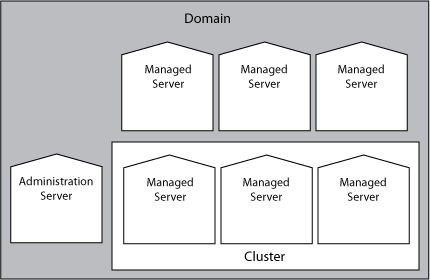2 Key Concepts
This chapter describes Oracle Fusion Middleware key concepts. It includes the following sections:
2.1 Key Oracle Fusion Middleware Concepts
Oracle Fusion Middleware provides two types of components:
-
A Java component, which is an Oracle Fusion Middleware component that is deployed as one or more Java EE applications and a set of resources. Java components are deployed to an Oracle WebLogic Server domain as part of a domain template. Examples of Java components are the Oracle SOA Suite and Oracle WebCenter components.
-
A system component, which is a manageable process that is not deployed as a Java application. Instead, a system component is managed by Oracle Process Manager and Notification (OPMN). The system components are:
-
Oracle HTTP Server
-
Oracle Web Cache
-
Oracle Internet Directory
-
Oracle Virtual Directory
-
Oracle Forms Services
-
Oracle Reports
-
Oracle Business Intelligence Discoverer
-
Oracle Business Intelligence
-
A Java component and a system component are peers.
After installing and configuring Oracle Fusion Middleware, the environment contains the following:
-
An Oracle WebLogic Server domain, which contains one Administration Server and one or more Managed Servers. The Administration Server contains the Oracle WebLogic Server Administration Console and Oracle Enterprise Manager Fusion Middleware Control. The Managed Servers contain components, such as Oracle WebCenter and Oracle SOA Suite.
-
If the environment includes system components, one or more Oracle instances.
-
A metadata repository, if the installed components require one. For example, Oracle SOA Suite requires a metadata repository.
The environment also includes a Middleware home, which consists of the Oracle WebLogic Server home, and, optionally, one or more Oracle homes.
2.2 Oracle Fusion Middleware Deployment Topology
Figure 2-1 shows an Oracle Fusion Middleware deployment topology.
Figure 2-1 Oracle Fusion Middleware Enterprise Deployment Architecture
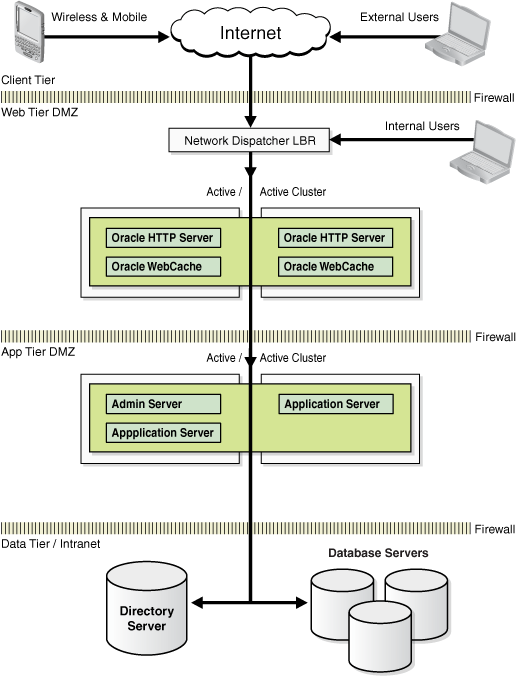
Description of "Figure 2-1 Oracle Fusion Middleware Enterprise Deployment Architecture"
As shown in Figure 2-1, this topology represents a multi-tiered architecture. Users access the system from the client tier. Requests go through a hardware load balancer, which then routes them to a Web server cluster, running Oracle HTTP Server. Web servers route the requests to the WebLogic cluster. Applications running on the WebLogic cluster then interact with the database cluster to service the request.
2.3 Oracle Fusion Middleware Environment
After installation, a typical Oracle Fusion Middleware environment contains the following (Figure 2-2):
-
One Oracle WebLogic Server domain, which contains one Administration Server and one or more Managed Servers. See Section 2.4, "What Is an Oracle WebLogic Server Domain?".
-
If system components are installed, they are configured in an Oracle Instance. See Section 2.5, "What Is an Oracle Instance?".
-
A metadata repository, if the installed components require one. For example, Oracle SOA Suite requires a metadata repository. See Section 3.2, "Oracle Metadata Repository".
-
A Middleware home, which contains product binary files. See Section 2.6, "What Is a Middleware Home?". Note that the product binary files will change as a result of patching. The configuration of the product binaries change as you configure and create a new data source.
Figure 2-2 shows an Oracle Fusion Middleware environment with an Oracle WebLogic Server domain that contains an Administration Server, two Managed Servers, and an Oracle instance. The environment also contains a metadata repository.
Figure 2-2 Oracle Fusion Middleware Environment
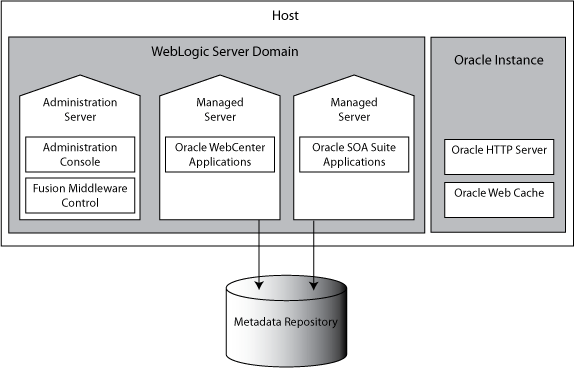
Description of "Figure 2-2 Oracle Fusion Middleware Environment"
2.4 What Is an Oracle WebLogic Server Domain?
An Oracle WebLogic Server domain is a logically related group of Java components. A domain includes a special Oracle WebLogic Server instance called the Administration Server, which is the central point from at which configuration and management of all resources in the domain occur. Usually, you configure an additional domain to include additional Oracle WebLogic Server instances called Managed Servers. You can deploy Java components, such as Web applications, Enterprise Java Beans (EJB), and Web services, and other resources to the Managed Servers and uses the Administration Server for configuration and management purposes only.
Managed servers in a domain can be grouped together into a cluster.
The directory structure of a domain is separate from the directory structure of the Oracle WebLogic Server home. It can reside anywhere; it need not be within the Middleware home directory.
A domain is a peer of an Oracle instance. Both contain specific configurations outside of their Oracle homes.
Figure 2-3 shows a domain with an Administration Server, three standalone Managed Servers, and three Managed Servers in a cluster.
For more information about domain configuration see the Oracle Fusion Middleware Understanding Domain Configuration for Oracle WebLogic Server.
The following topics describe entities in the domain:
2.4.1 What Is the Administration Server?
The Administration Server operates as the central control entity for the configuration of the entire domain. It maintains the domain's configuration documents and distributes changes in the configuration documents to Managed Servers. The Administration Server serves as a central location from which to monitor all resources in a domain.
Each domain must have one server instance that acts as the Administration Server.
To interact with the Administration Server,you can use the Oracle WebLogic Server Administration Console, Oracle WebLogic Scripting Tool (WLST), or create your own Java Management Extension (JMX) client. In addition, you can use Oracle Enterprise Manager Fusion Middleware Control (Fusion Middleware Control Console) for some tasks.
Oracle WebLogic Server Administration Console and Fusion Middleware Control run in the Administration Server. Oracle WebLogic Server Administration Console is the Web-based administration console used to manage the resources in an Oracle WebLogic Server domain, including the Administration Server and Managed Servers. The Web-based Fusion Middleware Control is used to manage Oracle Fusion Middleware, including components such as Oracle HTTP Server and Oracle Portal and product suites such as Oracle SOA Suite, Oracle WebCenter, and Oracle Identity Management.
2.4.2 Managed Servers and Managed Server Clusters
Managed servers host business applications, application components, Web services, and their associated resources. To optimize performance, Managed Servers maintain a read-only copy of the domain's configuration document. When a Managed Server starts up, it connects to the domain's Administration Server to synchronize its configuration document with the document that the Administration Server maintains.
When you create a domain, you create it using a particular domain template. The domain template contains all of the information you would like to include in your domain configuration. The template can then be used for additional installations. That template supports a particular component or group of components, such as the Oracle SOA Suite. The Managed Servers in the domain are created specifically to host those particular Oracle Fusion Middleware components.
Oracle Fusion Middleware Java components (such as Oracle SOA Suite, Oracle WebCenter, and some Oracle Identity Management components), as well as customer-developed applications, are deployed to Managed Servers in the domain.
Managed servers are Java Virtual Machine (JVM) processes.
If you want to add other components, such as Oracle WebCenter, to a domain that was created using a template that supports another component, you can extend the domain by creating additional Managed Servers in the domain, using a domain template for the component that you want to add. For more information, see "Extending A Domain to Support Additional Components" in the Oracle Fusion Middleware Administrator's Guide.
For production environments that require increased application performance, throughput, or high availability, you can configure two or more Managed Servers to operate as a cluster. A cluster is a collection of multiple Oracle WebLogic Server server instances running simultaneously and working together to provide increased scalability and reliability. In a cluster, most resources and services are deployed identically to each Managed Server (as opposed to a single Managed Server), enabling failover and load balancing. A single domain can contain multiple Oracle WebLogic Server clusters, as well as multiple Managed Servers that are not configured as clusters. The key difference between clustered and non-clustered Managed Servers is support for failover and load balancing. These features are available only in a cluster of Managed Servers.
For more information see"Understanding WebLogic Server Clustering" in Oracle Fusion Middleware Using Clusters for Oracle WebLogic Server
2.4.3 What Is Node Manager?
Node Manager is a Java utility that runs as a separate process from Oracle WebLogic Server and enables you to perform common operations for a Managed Server, regardless of its location with respect to its Administration Server. While use of Node Manager is optional, it provides valuable benefits if your Oracle WebLogic Server environment hosts applications with high-availability requirements. The Node Manager performs some of the following operations:
-
Start
-
Stop
-
Process Monitoring
-
Death Detection
-
Restart
If you run Node Manager on a computer that hosts Managed Servers, you can start and stop the Managed Servers remotely using the Fusion Middleware Control Console or the command line. Node Manager can also automatically restart a Managed Server after an unexpected failure.
For more information about Node Manager see the Oracle Fusion Middleware Node Manager Administrator's Guide for Oracle WebLogic Server.
2.5 What Is an Oracle Instance?
An Oracle instance contains one or more system components, such as Oracle Web Cache, Oracle HTTP Server, or Oracle Internet Directory. The system components in an Oracle instance must reside on the same computer. An Oracle instance directory contains updateble files, such as configuration files, log files, and temporary files.
An Oracle instance is a peer of an Oracle WebLogic Server domain. Both contain specific configurations outside of their Oracle homes.
The directory structure of an Oracle instance is separate from the directory structure of the Oracle home. It can reside anywhere; it need not be within the Middleware home directory.
2.6 What Is a Middleware Home?
A Middleware home consists of the Oracle WebLogic Server home, and, optionally, one or more Oracle homes.
A Middleware home can reside on a local file system or on a remote shared disk that is accessible through as network file system (NFS).
2.7 What Is a WebLogic Server Home?
The WebLogic home is the root directory in which Oracle WebLogic Server is installed. A WebLogic Server home contains installed files necessary to host a WebLogic Server. The WebLogic Server home directory is a peer of Oracle home directories and resides within the directory structure of the Middleware home.
The WebLogic home directory contains only product binary files that are mostly read only until the files are either patched or upgraded.
2.8 What Is an Oracle Home?
An Oracle home contains installed files necessary to host a specific product. For example, the SOA Oracle home contains a directory that contains binary and library files for Oracle SOA Suite.
An Oracle home resides within the directory structure of the Middleware home. Each Oracle home can be associated with multiple Oracle instances or Oracle WebLogic Server domains.
The Oracle home directory contains only product binary files that are mostly read only until the files are either patched or upgraded.
2.9 Oracle Fusion Middleware Directory Structure and Concepts
During the installation process, you are asked for a variety of directory locations. This section defines each of these directories and explains the contents of each directory.
This section includes the following topics:
2.9.1 Middleware Home and WebLogic Home Directories
The top-level directory for all Oracle Fusion Middleware products is called the Middleware home; this directory is created when Oracle WebLogic Server is installed. The WebLogic home directory is inside the Middleware home, and is also created when Oracle WebLogic Server is installed. Figure 2-4 shows the directory structure after a Oracle WebLogic Server installation.
Figure 2-4 Directory Structure After Oracle WebLogic Server Installation
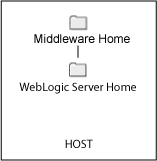
Description of "Figure 2-4 Directory Structure After Oracle WebLogic Server Installation"
2.9.2 Oracle Home Directory
Each Oracle Fusion Middleware product must be installed in its own Oracle home location. The software binaries are installed into the Oracle home; no runtime process can write to this directory.
The Oracle home directories (in this case, the SOA Oracle home) for each product must reside inside an existing Middleware home directory (see Figure 2-5).
Figure 2-5 Directory Structure with An Oracle Home Directory
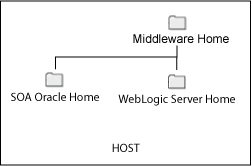
Description of "Figure 2-5 Directory Structure with An Oracle Home Directory"
The Oracle home directory can be created in the following ways:
-
Before running the installation, you can create your Oracle home directory on your system. Remember that the Oracle home must reside inside the Middleware home directory, and it must also be an empty directory. Then, when you run the installer and are asked to provide the location of your Oracle home, you can specify the directory you have created.
-
While running the installer, you can specify the name of a new directory. This directory are automatically be created for you by the installer and will be located inside the Middleware home directory.
2.9.3 WebLogic Domain
After a product is installed, it can be configured into an Oracle WebLogic Server Domain (see Section 2.4, "What Is an Oracle WebLogic Server Domain?".
The User Projects directory is created when you create or configure a domain (in this case, a SOA domain). By default, new domains are created inside the Domains folder, but you can choose to create these elsewhere.
Figure 2-6 Directory Structure after an WebLogic Domain is Created
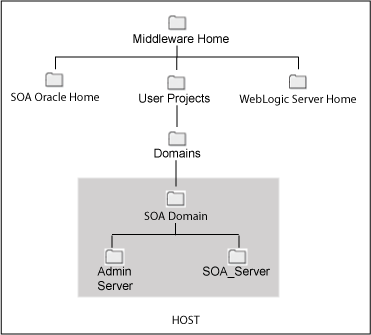
Description of "Figure 2-6 Directory Structure after an WebLogic Domain is Created"
2.9.4 Multiple Products with Multiple Oracle WebLogic Server Domains
If you install multiple products and choose to create a separate domain for each product, then your directory structure would look something like the one shown in Figure 2-7.
Figure 2-7 Directory Structure with Multiple Oracle Fusion Middleware Products
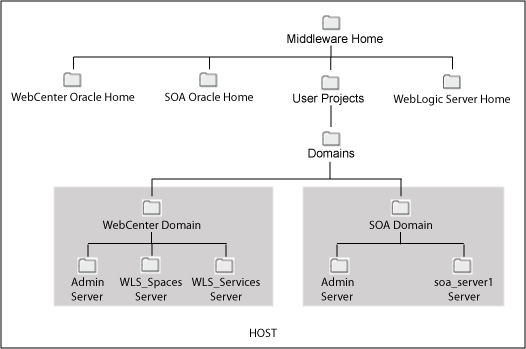
Description of "Figure 2-7 Directory Structure with Multiple Oracle Fusion Middleware Products"
Each product has its own Oracle home directory. To differentiate among all the product Oracle home directories, the installation guides typically refer to each Oracle home by product name; for example, the Oracle home for Oracle SOA Suite is referred to as the SOA Oracle home, while the Oracle home for Oracle WebCenter Suite is referred to as the WebCenter Oracle home.
If you choose to create multiple domains on a single computer, ensure that each domain has a unique name.
For more information about multiple products and multiple domains, see the following documentation:
2.9.5 Domain Extension
During installation and configuration, you may choose to create an existing domain rather than to create a new domain. Extending a domain means that you add products and functionality to an existing domain. If, for example, you first install Oracle SOA Suite to create a new domain, then install Oracle WebCenter Suite while choosing to extend the existing Oracle SOA Suite domain, then your topology would look like the one shown in Figure 2-8.
Figure 2-8 Directory Structure with Multiple Oracle Fusion Middleware Products in a Single Domain
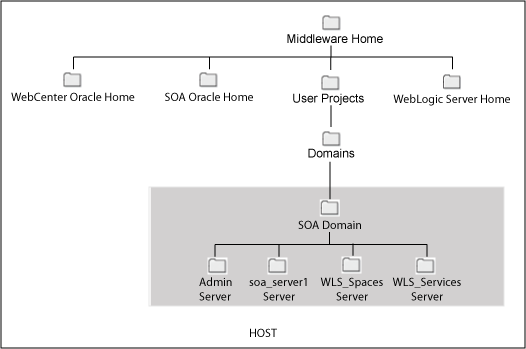
Description of "Figure 2-8 Directory Structure with Multiple Oracle Fusion Middleware Products in a Single Domain"
In essence, you are adding the products and functionality of Oracle WebCenter Suite to the existing Oracle SOA Suite domain.
2.9.6 Oracle Instance and Oracle WebLogic Server Domain
Figure 2-9 shows the directory structure when two products are installed, but one product (Oracle SOA Suite) is configured in a Oracle WebLogic Server domain (because it consists of Java components) while the other products (Oracle HTTP Server and Oracle Web Cache) is configured in an Oracle Instance (because it consists of system components):
Figure 2-9 Directory Structure with an Oracle Instance and a Oracle WebLogic Server Domain
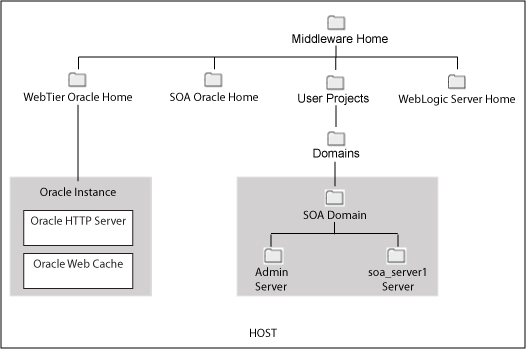
Description of "Figure 2-9 Directory Structure with an Oracle Instance and a Oracle WebLogic Server Domain"
2.10 What is a Farm?
A farm is a collection of components managed by Fusion Middleware Control. It can contain Oracle WebLogic Server domains, one Administration Server, one or more Managed Servers, and the Oracle Fusion Middleware components that are installed, configured, and running in the domain.
